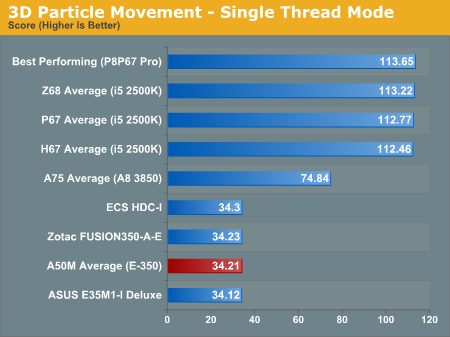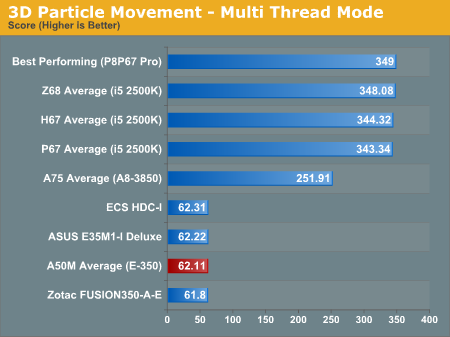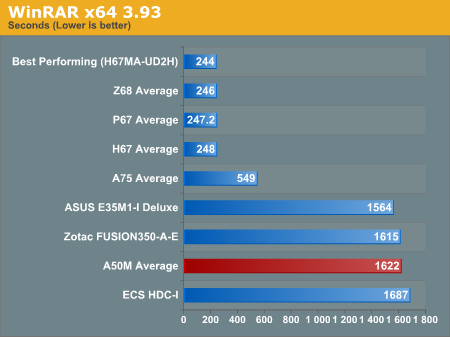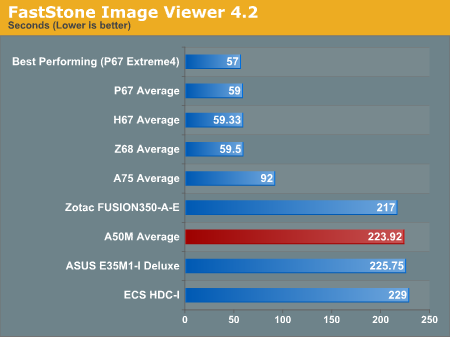Fusion E-350 Review: ASUS E35M1-I Deluxe, ECS HDC-I and Zotac FUSION350-A-E
by Ian Cutress on July 14, 2011 11:00 AM EST3D Movement Algorithm Test
This first benchmark uses various algorithms for three-dimensional simulation and movement of independent particles. The algorithms both employ uniform random number generation or normal distribution random number generation, and vary in various amounts of trigonometric operations, conditional statements, generation and rejection, fused operations, etc. The benchmark runs through six algorithms for a specified number of particles and steps, and calculates the speed of each algorithm, then sums them all for a final score. This is an example of a real world situation that a computational scientist may find themselves in, rather than a pure synthetic benchmark. The benchmark is also parallel between particles simulated, and we test the single thread performance as well as the multi-threaded performance.

There's not much to separate the Fusion boards here, but the lack of CPU power against higher performing parts is fairly obvious.

These results for the multithreading show a similar situation, however the Fusion boards also lose out here, as they are dual core whereas the others are quad core.
WinRAR x64 3.93
With 64-bit WinRAR, we compress the set of files used in the USB speed tests. WinRAR x64 3.93 attempts to use multithreading when possible.

FastStone Image Viewer 4.2
FastStone Image Viewer is a free piece of software I have been using for quite a few years now. It allows quick viewing of flat images, as well as resizing, changing color depth, adding simple text or simple filters. It also has a bulk image conversion tool, which we use here. The software currently operates only in single-thread mode, which should change in later versions of the software. For this test, we convert a series of 170 files, of various resolutions, dimensions and types (of a total size of 163MB), all to the .gif format of 640x480 dimensions.











67 Comments
View All Comments
sprockkets - Thursday, July 14, 2011 - link
I have the AsRock board. I get 18w idle and 24w under load via a killawatt device. Granted it uses an 80w power supply, but I'm kinda wondering how you got 59w for something that is practically the same setup in each board.IanCutress - Thursday, July 14, 2011 - link
I was using a less than ideal power supply for the power draw tests which was very inefficient in this range (<20% of maximum power), and unfortunately I don't have anything more appropriate at hand to test with. The comparisons (I believe) between the boards are more than relevant though. I will hopefully rectify this in future reviews of lower powered systems.Ian
formulav8 - Thursday, July 14, 2011 - link
Why didn't you wait to do power consumption tests then?bah12 - Thursday, July 14, 2011 - link
While not ideal, I'd say the whole point of this article was to illustrate the differences in the boards. Thus as long as they all suffered from the same inefficient PS, the information is not useless in that you can still draw a conclusion based on the differences at the board level. All and all, not ideal but useful.BushLin - Friday, July 15, 2011 - link
I once tried to reason with the fanboys at AMDZone on Anands behalf, defending that the reviews here were objective... I think I'm starting to believe that their might be some truth in their beliefs that the odds are stacked against AMD when their products are reviewed on here.At best, this review is a misguided. It focuses far too heavily on areas these systems are not aimed at, misinforms (or fails to inform) on areas that it's market are interested in and answers stupid questions that no-one is asking. Testing a GTX 580 with an E-350 at 4x PCI-E... really? Why not test out how well these work as a HTPC compared to something like ION and the latest Atom?
At worst, this review could almost be seen as a deliberate undermining of a technology that's potentially superior to it's Intel's offering and how often could you honestly say that since Core2?. Most of the tests are irrelevant (or become irrelevant when comparing to much higher TDP chips), the one test you did manage to do which is very relevant (power consumption) was so high that it prompted me to look at other reviews and take the time to write this comment!
This review has idle power consumption as at least 36w, Xbit have it at 7.3w even with a 880w PSU. One of these reviews has it very wrong, I know which one I'm more inclined to believe.
http://www.xbitlabs.com/articles/cpu/display/amd-e...
IKeelU - Friday, July 15, 2011 - link
I have to agree with your assessment of the review.- These boards are aimed at HTPC market, but the review was focused...elsewhere (frankly, I can't tell what the focus was).
- How is the audio quality? I was very interested in the ASUS board until I noticed it doesn't have 6-channel direct out. This is important!
- Another, less important, point: The features/specs for each board should come first. Double points for a feature comparison table.
AnandThenMan - Friday, July 15, 2011 - link
It is extremely unfortunate that Anandtech has sacrificed their integrity when it comes to reviewing some of AMD's products. I really hope that more and more people are made aware of what is going on, these reviews are downright dishonest.The most important question people need to ask is, why is this happening? What is the incentive for Anandtech.com to publish these misleading reviews?
ET - Saturday, July 16, 2011 - link
Can you explain what is dishonest or misleading about this review? I agree that it could be better, but I don't see anything to indicate that anything was falsified here.medi01 - Sunday, July 17, 2011 - link
Seriously?Cough "This review has idle power consumption as at least 36w, Xbit have it at 7.3w even with a 880w PSU. ", cough?
Oh, it's irrelevant, because we're comparing motherboards of the same platform? Orly? What if I read this, say "OMG it consumes so much energy" and go buy Atom?
Tell me how to get that 36w idle thing, what kind of PSU should be used, to justify 7.3w (with bloody 880w PSU!!!!) vs 36w please?
What are 5850 580gtx doing in this review?
Shameless...
Finraziel - Thursday, September 1, 2011 - link
Monstrously late reply... but I just can't not leave this comment... Did any of you actually read the xbit article? Those power draw measurements are measured between the PSU and the components, only measuring what the components are actually using, completely ignoring the efficiency of the PSU (the way xbitlabs has been testing for years I might add). So the fact that they were using an 880W PSU has absolutely zero bearing on their readings.Granted, it's still a shame that these boards couldn't have been tested with something like a pico psu, and I do agree the article could have been better (for instance, how much noise does that tiny fan on the ECS board actually make? apart from an easily missed remark in the conclusion nothing is said about it), but it's not as bad as you people are making it out to be.